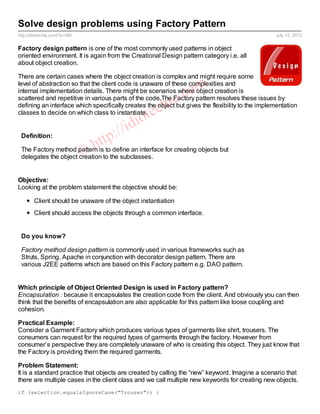Weitere ähnliche Inhalte
Kürzlich hochgeladen (20)
Idiotechie.com solve design problems using factory pattern
- 1. Solve design problems using Factory Pattern
http://idiotechie.com/?p=480 July 12, 2012
Factory design pattern is one of the most commonly used patterns in object
oriented environment. It is again from the Creational Design pattern category i.e. all
about object creation.
There are certain cases where the object creation is complex and might require some
level of abstraction so that the client code is unaware of these complexities and
ie. com
internal implementation details. There might be scenarios where object creation is
scattered and repetitive in various parts of the code.The Factory pattern resolves these issues by
ech
defining an interface which specifically creates the object but gives the flexibility to the implementation
ot
classes to decide on which class to instantiate.
:// idi
tttopdefine an interface for creating objects but
Definition:
h
The Factory method pattern is
©
delegates the object creation to the subclasses.
Objective:
Looking at the problem statement the objective should be:
Client should be unaware of the object instantiation
Client should access the objects through a common interface.
Do you know?
Factory method design pattern is commonly used in various frameworks such as
Struts, Spring, Apache in conjunction with decorator design pattern. There are
various J2EE patterns which are based on this Factory pattern e.g. DAO pattern.
Which principle of Object Oriented Design is used in Factory pattern?
Encapsulation : because it encapsulates the creation code from the client. And obviously you can then
think that the benefits of encapsulation are also applicable for this pattern like loose coupling and
cohesion.
Practical Example:
Consider a Garment Factory which produces various types of garments like shirt, trousers. The
consumers can request for the required types of garments through the factory. However from
consumer’s perspective they are completely unaware of who is creating this object. They just know that
the Factory is providing them the required garments.
Problem Statement:
It is a standard practice that objects are created by calling the “new” keyword. Imagine a scenario that
there are multiple cases in the client class and we call multiple new keywords for creating new objects.
if (selection.equalsIgnoreCase("Trouser")) {
- 2. return new Trouser();
} else if (selection.equalsIgnoreCase("Shirt")) {
return new Shirt();
}
If we now have to add jacket or sweater we have to keep on modifying the client code and further add
the new keyword. This creates a dependency on the client code and in turn makes it difficult to
maintain.
Another problem is that the client application has to know how many types of concrete classes are
com
available upfront. Later if we have to add another concrete class e.g. sweater or jacket then client code
has to be changed and recompiled.
ie.
ech
Solution:
ot
To resolve above problems factory pattern can be used explicitly.
idi
The first problem of accessing too many new keyword can be resolved by using a Factory class.
://
h ttp
The second problem can be solved by using an interface which the concrete classes will
implement and the client will always point to the interface class rather than the concrete classes.
©
So in this way client will be completely unaware of various types of concrete classes which will be
required.
What is an interface?
An Interfacein Java is a collection of method definitions without implementation.
The class which implements the interface has to provides the implementation and
must implement all the methods described in the interface. The interface is a
contract which tells the classes what to be done leaves it for the classes to decide
on how they can be implemented.
interface Bounceable {
void setBounce();
}
The below class diagram will give a complete overview of implementation of Factory Pattern:
Let’s take a look at the sample code to implement
- 3. Let’s take a look at the sample code to implement
the Factory Pattern:
GarmentType.java
public interface GarmentType {
String print();
}
ie. com
ot ech
:// idi Factory Pattern Class Diagram
Trouser.java h ttp
©
public class Trouser implements GarmentType {
@Override
public String print() {
System.out.println("Trouser Created");
return "Trouser";
}
}
Shirt.java
public class Shirt implements GarmentType {
@Override
public String print() {
System.out.println("Shirt Created");
return "Shirt";
}
}
GarmentFactory.java
public class GarmentFactory {
public static GarmentType createGarments(String selection) {
if (selection.equalsIgnoreCase("Trouser")) {
return new Trouser();
} else if (selection.equalsIgnoreCase("Shirt")) {
return new Shirt();
}
throw new IllegalArgumentException("Selection doesnot exist");
}
}
Client.java
- 4. public class Client {
public static void main(String[] args) {
System.out.println("Enter your selection:");
BufferedReader br = new BufferedReader(new
InputStreamReader(System.in));
String selection = null;
try {
selection = br.readLine();
} catch (IOException e) {
e.printStackTrace();
com
}
GarmentType objGarmentType =
ie.
GarmentFactory.createGarments(selection);
ech
System.out.println(objGarmentType.print());
}
}
ot
:// idi
Advantage of Factory Pattern:
h ttp
a)This client does not need to know about the subclass of objects which requires to be created. It
©
requires the reference to the interface and the factory object.
b)The object creation processes are taken away from the client to the factory and thereby decoupling
the client code with the object creation code. This in turn will help in reusability as this code can be
used by other clients.
c)The Factory pattern also helps in the scalability of the application as the client code only refers to the
interface and we can add more products implementing the interface without making many changes in
the client code.
d)Code maintainability is a beneficial if the application uses Factory pattern as the object creation is
centralized.

